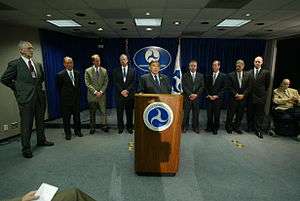National Surface Transportation Policy and Revenue Study Commission

The National Surface Transportation Policy and Revenue Study Commission was a panel created by Section 1909 of SAFETEA-LU (the Safe, Accountable, Flexible, Efficient Transportation Equity Act: A Legacy for Users, U.S. Public Law 109-59), signed into law by President George W. Bush on August 10, 2005. The commission was an attempt to study and develop a vision for the United States' surface transportation system. In laying out the parameters for the Commission, Section 1909 noted that “it is in the National interest to preserve and enhance the surface transportation system to meet the needs of the United States for the 21st century.”
Section 1909 charged the commission with reviewing the condition and future needs of the surface transportation system; recommending future roles and programs; and identifying finance mechanisms for the surface transportation system in the immediate, short and long terms. It is expected that the group’s recommendations will serve as a prelude to the reauthorization of SAFETEA-LU in 2009.
Commission Activities
The Commission undertook an aggressive outreach effort to learn about the issues facing the nation’s transportation system. A 77-member Blue Ribbon Panel of Transportation Experts was established to provide the Commission with recommendations and additional insight. This panel included experts from different levels of government, the private sector, and research and academic institutions.
The Commission held field hearings in ten cities: Dallas, Portland (Oregon), Memphis, New York, Las Vegas, Los Angeles, Atlanta, Washington, D.C., Minneapolis, and Chicago. During these hearings, 231 witnesses testified about a wide range of topics covering all surface transportation modes. The hearings often included tours of facilities, or discussion of issues unique to certain parts of the country. Several of these field hearings were cosponsored with major transportation stakeholder groups.
The Commission met in public and executive session in Washington, D.C., 12 times during the course of its activities, and heard from 62 expert witnesses during these sessions. Individual Commissioners regularly participated in conferences and meetings to solicit input from key transportation stakeholders, and provided interviews and editorial columns to newspapers.
The Commission also developed a public Web site, http://www.transportationfortomorrow.org, that included testimony from the field hearings and public sessions, as well as key information about the Commission’s work.
Final Report
The Commission released its report on January 15, 2008. The full text of Volumes 1 and 2 are available on the Commission’s Web Site, http://www.transportationfortomorrow.org.
The report concludes that the current surface transportation program in the United States should not be reauthorized in its current form. Instead, the report recommends development of a new Federal Compact focusing objectives of genuine national interest. The key elements of that compact would be:
- A strong federal role in surface transportation that will evolve to meet the national interest;
- Increased expenditures from all levels of government and the private sector to compensate for past investment failures while addressing significant increases in future demand;
- A commitment to make more effective use of taxpayers’ funds for the national interest;
- Federal funding that is performance-based and focused on cost-beneficial outcomes with accountability for the full range of economic, environmental, and social costs and benefits of investments; and
- Far-reaching program reform to eliminate waste and delays in federally funded program delivery.[1]
Members
The Commission included 12 members appointed by the President and Congressional leaders:

- Mary Peters (Chairman), Secretary, U.S. Department of Transportation
- Jack Schenendorf (Vice Chairman), of counsel, Covington & Burling
- Frank J. Busalacchi, Secretary, Wisconsin Department of Transportation
- Maria Cino, Former Deputy Secretary, U.S. Department of Transportation
- Rick Geddes, Director of Undergraduate Studies, Cornell University Department of Policy Analysis and Management
- Steve Heminger, Executive Director, Metropolitan Transportation Commission
- Frank McArdle, Senior Advisor, General Contractors Association of New York
- Steve Odland, Chairman and CEO, Office Depot
- Patrick Quinn, Co-Chairman, U.S. Xpress Enterprises, Inc.
- Matt Rose, CEO, Burlington Northern Santa Fe Railroad
- Tom Skancke, CEO, The Skancke Company
- Paul Weyrich, Chairman and CEO, Free Congress Foundation
References
External links
- National Surface Transportation Policy and Revenue Study Commission Web Site
- Transportation for Tomorrow, Part I" (YouTube Video)
- Transportation for Tomorrow, Part II (YouTube Video)